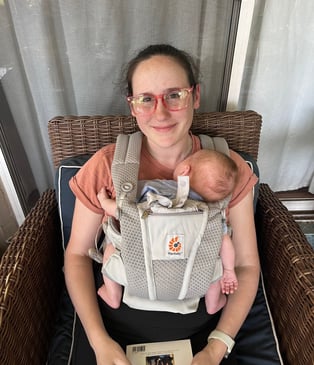Babywearing Basics & Safety
Learn about the magic and wonder of babywearing. See the amazing ways that babywearing benefits both babies and caregivers and learn about safe babywearing practices.
Anna Waters


Baby wearing can be such a beautiful way to connect with your little one while making life a little easier. It’s all about keeping your baby close, and feeling safe and loved while giving you the freedom to go about your day. Let’s take a moment to explore why baby wearing is so special and how to do it safely.
Why Baby wearing Feels So Right for Babies
Snuggles that Matter: Being close to you helps your baby feel secure and deeply loved. It’s a gentle way to build that precious bond.
A Safe Window to the World: While you carry them, your baby can quietly take in the sights and sounds around them, all from a comforting and secure place.
Better Rest: The soothing motion of being worn often helps babies fall asleep more easily—and stay asleep longer.
More Calm, More Smiles: Babies who are carried often feel more settled and content, which can mean fewer tears and a happier little one.
How Baby wearing Helps You Too
Hands-Free Ease: Keep your baby close while staying free to handle everyday tasks. Whether it’s making dinner or running errands, baby wearing helps you juggle it all.
Comfort for You: A good carrier supports your posture and helps balance the weight, making it easier on your body compared to other ways of carrying your baby.
Baby wearing is such a gentle, practical way to care for your baby while making space for yourself, too. Let’s walk through how to do it safely so you and your little one can enjoy all the benefits together.
So How do We Babywear Safely?
Baby wearing can often seem complicated but there are lots of resources available to help caregivers find a good and safe fit. Regardless of how you choose to carry, there are some basic safety rules that are important to follow. Using the acronym TICKS we can remember the most important safety rules.
T - Tight Carrier: This is especially for stretchy carriers such as the Moby wrap or Kony carrier. With those kinds of carriers, it is nearly impossible to over-tighten them and they should fit like a swimsuit. On the other hand with structured carriers, it is possible to over-tighten and you want to make sure that baby’s spine is in the appropriate share for their age. A “C” shape for newborns and a “J” Shape for older babies.
I - In View at All Times: You should always be able to see your baby’s face while wearing your baby carrier. It can be tempting to pull up some fabric to cover up a sleeping baby’s face but this can cause the baby to not get enough fresh air circulating and prevent them from getting enough oxygen.
C - Close Enough to Kiss: Babies airways are not well supported at birth and one of the ways that we can help make sure that they receive proper support so as not to block their airways is by keeping them close enough to kiss. This means that you should be able to kiss the top of your baby’s head without bending your neck down. Another way to put this is that the top of your baby’s head should be level with the bottom of your neck.
K - Keep Chin Off Chest: This step works with the T and C in Ticks to help protect your baby’s airways. If your carrier is too low or too loose then your baby can become slumped over in your carrier preventing them from properly oxygenating. It’s for your baby’s chin to be touching their shoulder, especially if they are sleeping, but we want to make sure that they aren’t slumped forward with their chin to their chest.
S - Supported Back: This step works with the “T” to make sure that your baby is held in a position to support their airways, maintain proper spine development, and will look different as your baby grows. In the newborn phase, we are looking for a “C” shaped spine where their buts are curled upwards. As they grow that will sift to more of a “J” shape as they learn to support themselves and sit up.
Wearing your baby properly will be more comfortable for both you and your baby and will help properly support their growing body. If you want help learning how to use your carrier correctly, please reach out to me and we can schedule a consultation.
